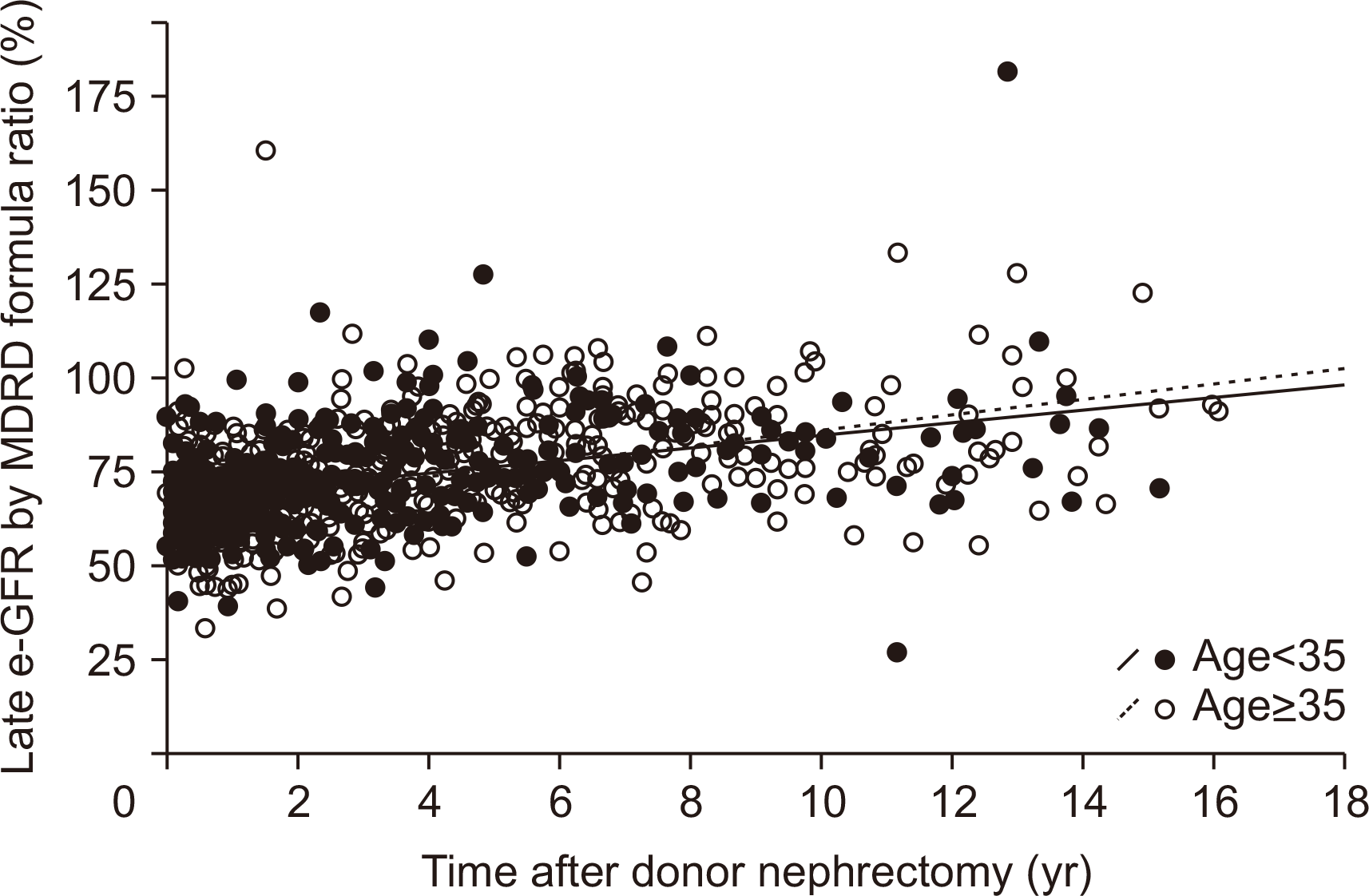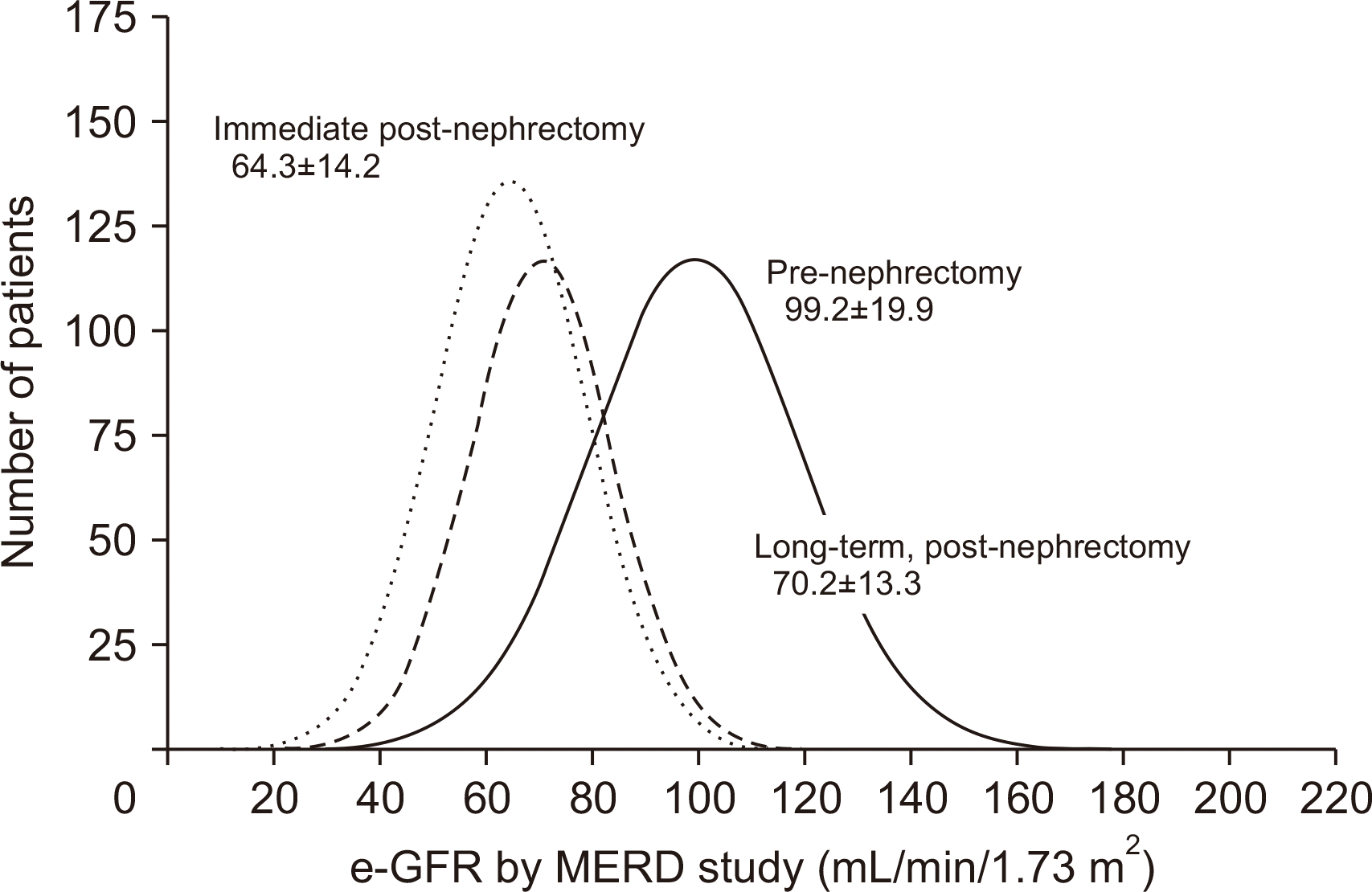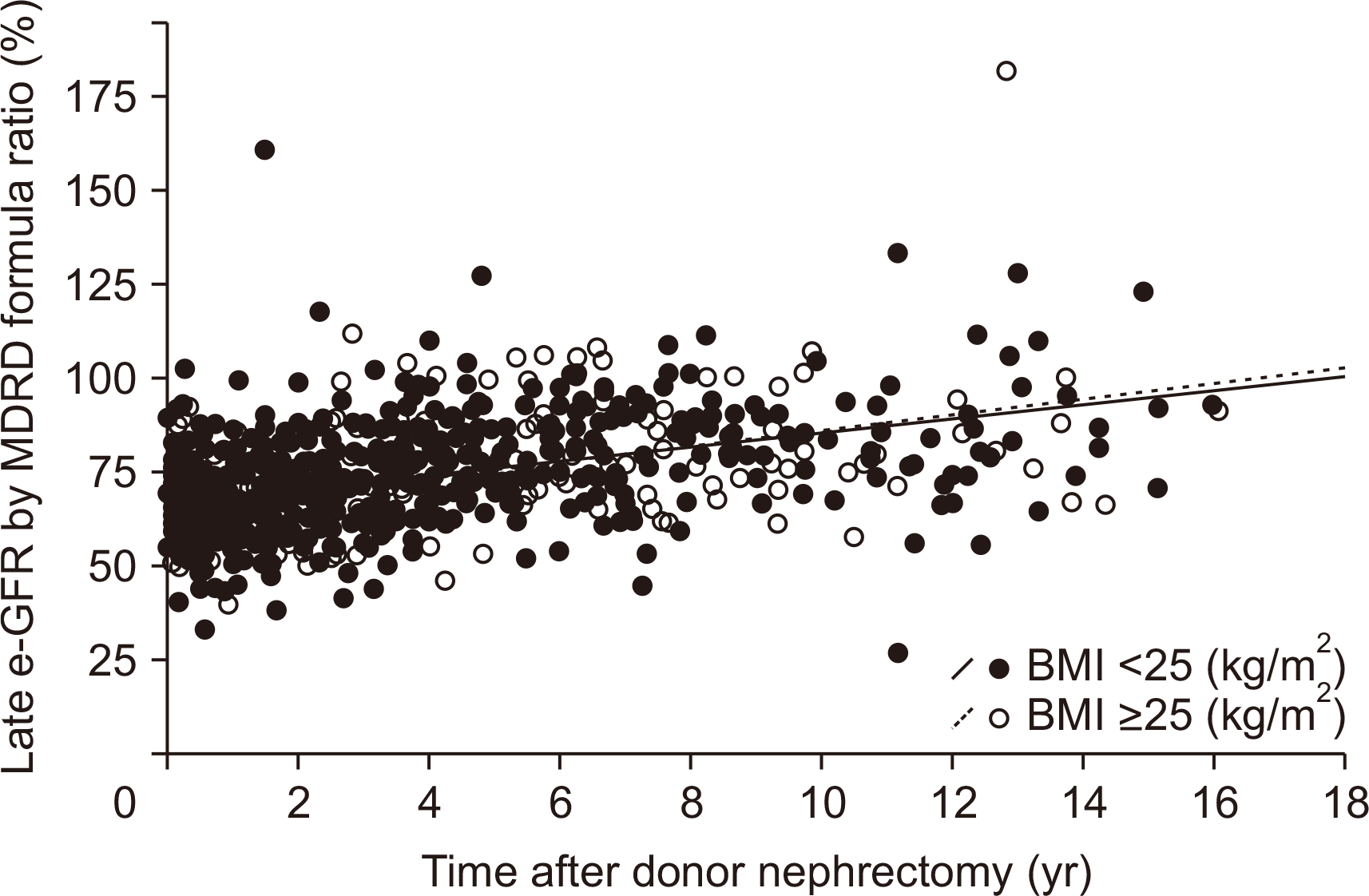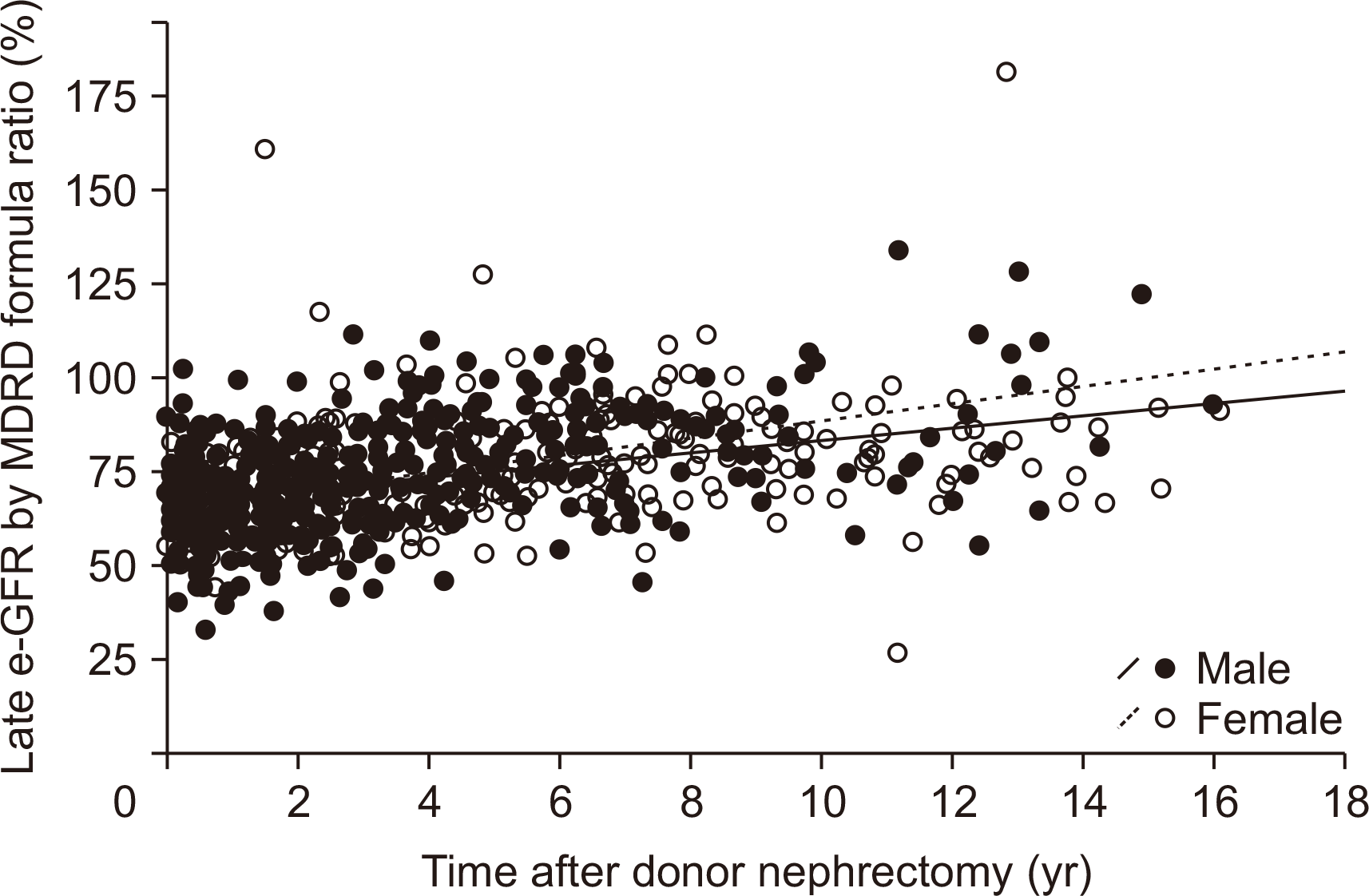1. Korean Network for Organ Sharing (KONOS). 2020. 2017 Annual data report [Internet]. KONOS;Seoul: Available from:
http://www.konos.go.kr. cited 2020 May 27.
2. United States Renal Data System. 2017. USRDS 2017 annual data report [Internet]. Atlas of End-Stage Renal Disease in the United States, National Institutes of Health, National Institute of Diabetes and Digestive and Kidney Diseases;Bethesda (MD): Available from
https://www.usrds.org/2017/view/. cited 2020 May 27.
4. Edgren J, Laasonen L, Kock B, Brotherus JW, Pasternack A, Kuhlbäck B. 1976; Kidney function and compensatory growth of the kidney in living kidney donors. Scand J Urol Nephrol. 10:134–6. DOI:
10.3109/00365597609179673. PMID:
948722.

5. Orecklin JR, Craven JD, Lecky JW. 1973; Compensatory renal hypertrophy: a morphologic study in transplant donors. J Urol. 109:952–4. DOI:
10.1016/S0022-5347(17)60591-3. PMID:
4575812.

6. Takagi T, Mir MC, Sharma N, Remer EM, Li J, Demirjian S, et al. 2014; Compensatory hypertrophy after partial and radical nephrectomy in adults. J Urol. 192:1612–8. DOI:
10.1016/j.juro.2014.06.018. PMID:
24931802.

7. Saxena AB, Myers BD, Derby G, Blouch KL, Yan J, Ho B, et al. 2006; Adaptive hyperfiltration in the aging kidney after contralateral nephrectomy. Am J Physiol Renal Physiol. 291:F629–34. DOI:
10.1152/ajprenal.00329.2005. PMID:
16525160.

8. Srivastava T, Hariharan S, Alon US, McCarthy ET, Sharma R, El-Meanawy A, et al. 2018; Hyperfiltration-mediated injury in the remaining kidney of a transplant donor. Transplantation. 102:1624–35. DOI:
10.1097/TP.0000000000002304. PMID:
29847501. PMCID:
PMC6153061.

9. Praga M. 2005; Synergy of low nephron number and obesity: a new focus on hyperfiltration nephropathy. Nephrol Dial Transplant. 20:2594–7. DOI:
10.1093/ndt/gfi201. PMID:
16223782.

10. Hostetter TH, Olson JL, Rennke HG, Venkatachalam MA, Brenner BM. 2001; Hyperfiltration in remnant nephrons: a potentially adverse response to renal ablation. J Am Soc Nephrol. 12:1315–25. PMID:
11373357.

11. Mjøen G, Hallan S, Hartmann A, Foss A, Midtvedt K, Øyen O, et al. 2014; Long-term risks for kidney donors. Kidney Int. 86:162–7. DOI:
10.1038/ki.2013.460. PMID:
24284516.

12. González E, Gutiérrez E, Morales E, Hernández E, Andres A, Bello I, et al. 2005; Factors influencing the progression of renal damage in patients with unilateral renal agenesis and remnant kidney. Kidney Int. 68:263–70. DOI:
10.1111/j.1523-1755.2005.00401.x. PMID:
15954916.
13. Locke JE, Reed RD, Massie A, MacLennan PA, Sawinski D, Kumar V, et al. 2017; Obesity increases the risk of end-stage renal disease among living kidney donors. Kidney Int. 91:699–703. DOI:
10.1016/j.kint.2016.10.014. PMID:
28041626. PMCID:
PMC5313335.

14. Ito K, Nakashima J, Hanawa Y, Oya M, Ohigashi T, Marumo K, et al. 2004; The prediction of renal function 6 years after unilateral nephrectomy using preoperative risk factors. J Urol. 171:120–5. DOI:
10.1097/01.ju.0000100981.11470.2f. PMID:
14665858.

15. Esposito C, Plati A, Mazzullo T, Fasoli G, De Mauri A, Grosjean F, et al. 2007; Renal function and functional reserve in healthy elderly individuals. J Nephrol. 20:617–25. PMID:
17918149.
16. Rook M, Bosma RJ, van Son WJ, Hofker HS, van der Heide JJ, ter Wee PM, et al. 2008; Nephrectomy elicits impact of age and BMI on renal hemodynamics: lower postdonation reserve capacity in older or overweight kidney donors. Am J Transplant. 8:2077–85. DOI:
10.1111/j.1600-6143.2008.02355.x. PMID:
18727700.

17. Fehrman-Ekholm I, Dunér F, Brink B, Tydén G, Elinder CG. 2001; No evidence of accelerated loss of kidney function in living kidney donors: results from a cross-sectional follow-up. Transplantation. 72:444–9. DOI:
10.1097/00007890-200108150-00015. PMID:
11502974.
18. Lam NN, Lentine KL, Levey AS, Kasiske BL, Garg AX. 2015; Long-term medical risks to the living kidney donor. Nat Rev Nephrol. 11:411–9. DOI:
10.1038/nrneph.2015.58. PMID:
25941060.

19. O'Keeffe LM, Ramond A, Oliver-Williams C, Willeit P, Paige E, Trotter P, et al. 2018; Mid- and long-term health risks in living kidney donors: a systematic review and meta-analysis. Ann Intern Med. 168:276–84. DOI:
10.7326/M17-1235. PMID:
29379948.
20. Kasiske BL, Ma JZ, Louis TA, Swan SK. 1995; Long-term effects of reduced renal mass in humans. Kidney Int. 48:814–9. DOI:
10.1038/ki.1995.355. PMID:
7474669.

21. Kasiske BL, Anderson-Haag T, Israni AK, Kalil RS, Kimmel PL, Kraus ES, et al. 2015; A prospective controlled study of living kidney donors: three-year follow-up. Am J Kidney Dis. 66:114–24. DOI:
10.1053/j.ajkd.2015.01.019. PMID:
25795073. PMCID:
PMC4485526.

22. Seo MH, Lee WY, Kim SS, Kang JH, Kang JH, Kim KK, et al. 2019; 2018 Korean Society for the Study of Obesity guideline for the management of obesity in Korea. J Obes Metab Syndr. 28:40–5. DOI:
10.7570/jomes.2019.28.1.40. PMID:
31089578. PMCID:
PMC6484940.

23. Pottel H, Delanaye P, Weekers L, Selistre L, Goffin K, Gheysens O, et al. 2017; Age-dependent reference intervals for estimated and measured glomerular filtration rate. Clin Kidney J. 10:545–51. DOI:
10.1093/ckj/sfx026. PMID:
28852494. PMCID:
PMC5570001.

24. Weitz J, Koch M, Mehrabi A, Schemmer P, Zeier M, Beimler J, et al. 2006; Living-donor kidney transplantation: risks of the donor: benefits of the recipient. Clin Transplant. 20(Suppl 17):13–6. DOI:
10.1111/j.1399-0012.2006.00595.x. PMID:
17100696.
25. Ibrahim HN, Foley R, Tan L, Rogers T, Bailey RF, Guo H, et al. 2009; Long-term consequences of kidney donation. N Engl J Med. 360:459–69. DOI:
10.1056/NEJMoa0804883. PMID:
19179315. PMCID:
PMC3559132.

26. Rizvi SA, Naqvi SA, Jawad F, Ahmed E, Asghar A, Zafar MN, et al. 2005; Living kidney donor follow-up in a dedicated clinic. Transplantation. 79:1247–51. DOI:
10.1097/01.TP.0000161666.05236.97. PMID:
15880079.

27. Muzaale AD, Massie AB, Wang MC, Montgomery RA, McBride MA, Wainright JL, et al. 2014; Risk of end-stage renal disease following live kidney donation. JAMA. 311:579–86. DOI:
10.1001/jama.2013.285141. PMID:
24519297. PMCID:
PMC4411956.

28. Hartmann A, Fauchald P, Westlie L, Brekke IB, Holdaas H. 2003; The risk of living kidney donation. Nephrol Dial Transplant. 18:871–3. DOI:
10.1093/ndt/gfg069. PMID:
12686656.

29. ter Wee PM, Tegzess AM, Donker AJ. 1994; Pair-tested renal reserve filtration capacity in kidney recipients and their donors. J Am Soc Nephrol. 4:1798–808. PMID:
8068878.

30. Rook M, Hofker HS, van Son WJ, Homan van der Heide JJ, Ploeg RJ, Navis GJ. 2006; Predictive capacity of pre-donation GFR and renal reserve capacity for donor renal function after living kidney donation. Am J Transplant. 6:1653–9. DOI:
10.1111/j.1600-6143.2006.01359.x. PMID:
16827867.

31. Goldfarb DA, Matin SF, Braun WE, Schreiber MJ, Mastroianni B, Papajcik D, et al. 2001; Renal outcome 25 years after donor nephrectomy. J Urol. 166:2043–7. DOI:
10.1016/S0022-5347(05)65502-4. PMID:
11696703.

32. Gossmann J, Wilhelm A, Kachel HG, Jordan J, Sann U, Geiger H, et al. 2005; Long-term consequences of live kidney donation follow-up in 93% of living kidney donors in a single transplant center. Am J Transplant. 5:2417–24. DOI:
10.1111/j.1600-6143.2005.01037.x. PMID:
16162190.

33. Garg AX, Muirhead N, Knoll G, Yang RC, Prasad GV, Thiessen-Philbrook H, et al. 2006; Proteinuria and reduced kidney function in living kidney donors: a systematic review, meta-analysis, and meta-regression. Kidney Int. 70:1801–10. DOI:
10.1038/sj.ki.5001819. PMID:
17003822.






 PDF
PDF Citation
Citation Print
Print







 XML Download
XML Download